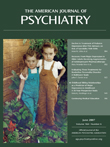Abacavir Sulfate and Mania in HIV
To The Editor: Case reports of manic episodes have implicated non-nucleoside reverse transcriptase inhibitors such as zidovudine, didanosine, lamivudine, and stavudine (1) . We describe the case of a patient with mania that was associated with abacavir sulfate, another non-nucleoside reverse transcriptase inhibitor.
The patient was a 47-year-old man infected with human immunodeficiency virus (HIV) for 9 years prior to a manic episode. He had a long history of alcohol and substance abuse, but had been abstinent for the past 10 years. Hepatitis C was confirmed at the time of his HIV diagnosis. Over time, transaminases remained below two times the normal values, and the patient was never treated for this infection. No personal psychiatric history was reported, but he had one sibling who had a diagnosis of schizophrenia. Soon after his HIV diagnosis, first-line therapy with zidovudine, lamivudine, and delavirdine was initiated. The patient remained with the same therapy for 9 years. His plasmatic viral load was at a level of detection (<50 copies/ml), and he had a CD4-cell count of approximately 200 cells/mm 3 . He never suffered from any opportunistic infection, which is an indication of good immunity. His antiretroviral regimen was changed to abacavir, lamivudine, and lopinavir/ritonavir in an attempt to increase his CD4-cell count. During this period, his CD4-cell count dropped to 159 cells/mm 3 , despite a viral load that remained below the level of detection. One week after initiating the new regimen, the patient experienced emotional lability, irritability, decreased sleep, increased goal-directed activity, increased libido, increased difficulty remaining focused, and a sense of being disorganized. He was reassessed, and no signs or symptoms of hypersensitivity reaction to abacavir were noted. His creatinine, thyroid stimulating hormone, and cortisol levels were within normal values. His symptoms persisted for 3 months, during which time, clonazepam 0.5 mg at bedtime was occasionally used for insomnia, and he was referred to a psychiatrist. On interview, the patient was cooperative but euphoric. Psychomotor agitation was noted with pressured speech and emotional lability. No evidence of HIV-associated dementia or opportunistic infection was observed; specifically, sensorium was clear, and memory and executive functions were grossly intact. Following a provisional diagnosis of abacavir-induced mania, abacavir was discontinued and replaced by stavudine. No other medication was prescribed. The patient’s symptoms remitted gradually, and he reported feeling much better 4 weeks later. Since abacavir was considered his best therapeutic option, the patient was offered a re-challenge but declined. At the 13-month follow-up, no recurrence of mania was observed. The time sequence, remission of symptoms following discontinuation of abacavir, absence of endocrinopathy, and absence of personal history of mood disorder strongly suggest that abacavir was implicated in the initiation and maintenance of the patient’s manic episode.
Studies in HIV-infected patients have shown substantial penetration of abacavir into the CSF, with a CSF-to-plasma ratio between 0.3 and 0.44. To date, no putative mechanism has been suggested to explain the association between non-nucleoside reverse transcriptase inhibitors and mania.
1. Halman MH, Bialer P, Worth JL, Rourke SB: HIV disease/AIDS, in The American Psychiatric Publishing Textbook of Consultation-Liaison Psychiatry: Psychiatry in the Medically Ill. Edited by Wise MG, Rundell JR. Washington, DC, American Psychiatric Publishing, 2002, pp 825–826Google Scholar
2. Ziagen: Product Monograph. Mississauga, Canada, GlaxoSmithKline, Inc., 2005Google Scholar



